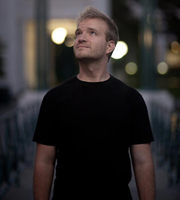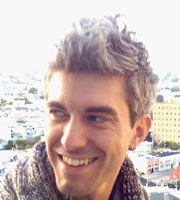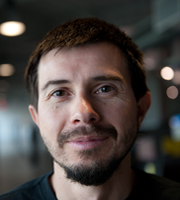Game Developers Conference 2012
Wanna know some tips and tricks in regarding fx in the game industry? You're in luck! A whole slew of bad asses from Naughty Dog will be giving talks at the Game Developers Conference this year. Hold on to your hats and let me brush over a few of the talented people who will be giving talks from our studio.
 Keith Geurrette: Lead Visual Effects Artist on Uncharted, will be giving a 60 minute lecture on our fx pipeline and the unique situations we are often tasked with resolving. He'll be going over some tricks we use in creating dynamic textures for our particle systems. Keith is super clever when it comes to thinking on your feet and a lot of what he creates at work usually leaves me thinking "Damn, I don't think I would have thought of that". He is going to be giving away a lot of good info at his lecture so I wouldn't miss it if I were you.
Keith Geurrette: Lead Visual Effects Artist on Uncharted, will be giving a 60 minute lecture on our fx pipeline and the unique situations we are often tasked with resolving. He'll be going over some tricks we use in creating dynamic textures for our particle systems. Keith is super clever when it comes to thinking on your feet and a lot of what he creates at work usually leaves me thinking "Damn, I don't think I would have thought of that". He is going to be giving away a lot of good info at his lecture so I wouldn't miss it if I were you. Eben Cook: Lead Visual Effects Artist on The Last of Us, will be giving a 25 minute lecture on something a little more specific. Eben will be discussing the hall flood scene in the Cruise Ship level of Uncharted. He came up with several uber clever techniques to tackle some of the difficult limitations we face daily for the flood. Eben has a brain that I would eat if it could make me smarter. You'll kick yourself if you miss this one too.
Eben Cook: Lead Visual Effects Artist on The Last of Us, will be giving a 25 minute lecture on something a little more specific. Eben will be discussing the hall flood scene in the Cruise Ship level of Uncharted. He came up with several uber clever techniques to tackle some of the difficult limitations we face daily for the flood. Eben has a brain that I would eat if it could make me smarter. You'll kick yourself if you miss this one too. Marshall Robin: Rendering Programmer on Uncharted and The Last of Us, will be giving a 60 minute lecture on the tech behind our particle effects in Uncharted. His talk will cover our particle tool pipeline, data structures, and shader techniques. That is just a rough idea of what will be covered. Marshall was our dedicated programmer for fx on Uncharted 3. The tech he gives us to be able to do what we do is brilliant. That shouldn't surprise you. The man is brilliant. This talk would be good for artists to see because understanding how things work is all a part of creating great work. You have to know how your are doing something so you can collaborate with people like Marshall to push the tools. Respect your programmers world.
Marshall Robin: Rendering Programmer on Uncharted and The Last of Us, will be giving a 60 minute lecture on the tech behind our particle effects in Uncharted. His talk will cover our particle tool pipeline, data structures, and shader techniques. That is just a rough idea of what will be covered. Marshall was our dedicated programmer for fx on Uncharted 3. The tech he gives us to be able to do what we do is brilliant. That shouldn't surprise you. The man is brilliant. This talk would be good for artists to see because understanding how things work is all a part of creating great work. You have to know how your are doing something so you can collaborate with people like Marshall to push the tools. Respect your programmers world. Carlos Gonzalez-Ochoa: Rendering Programmer on Uncharted, will be giving a 60 minute advanced programming lecture on the water system in Uncharted. I have mentioned Carlos before in this blog and if you want to to know what his water systems can do, you need only look at the ship graveyard level below. This procedural water system will blow you away. I worked a lot with Carlos using his system for levels in Uncharted 3 and it never stopped amazing me. He is also the creator of our flow shader that we use in our water shader. Even if the dialogue in this talk is over your head, I wouldn't miss it because you will get to see this tech in action and it iiiiiiiiiiiiiiissssssssss niiiiiiiiiiiiiiiiiiiiiice.
Carlos Gonzalez-Ochoa: Rendering Programmer on Uncharted, will be giving a 60 minute advanced programming lecture on the water system in Uncharted. I have mentioned Carlos before in this blog and if you want to to know what his water systems can do, you need only look at the ship graveyard level below. This procedural water system will blow you away. I worked a lot with Carlos using his system for levels in Uncharted 3 and it never stopped amazing me. He is also the creator of our flow shader that we use in our water shader. Even if the dialogue in this talk is over your head, I wouldn't miss it because you will get to see this tech in action and it iiiiiiiiiiiiiiissssssssss niiiiiiiiiiiiiiiiiiiiiice.There will be other Dogs there giving talks so I suggest you get signed up asap. There are going to be a huge number of other talks to add some wrinkles to your brain, and who wouldn't want that!?
























